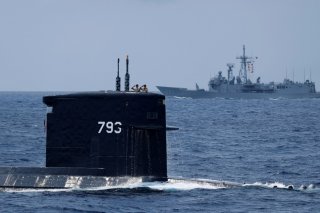Get Ready, China: Taiwan Is Poised to Become an Undersea Powerhouse
Taiwan took a major step toward its domestic submarine ambitions in late 2020 with the construction of a dedicated submarine production facility.
Here's What You Need to Remember: The RoCN’s most effective means to contest Chinese naval power is instead through sea denial, spearheaded by asymmetric submarine warfare. A large fleet of modernized Taiwanese attack submarines can impose serious costs on Chinese ships operating in the Taiwan Strait; they can likewise stall a potential Chinese incursion long enough to prevent a quick-and-easy annexation of the island, giving Taiwan’s allies time to coordinate a military and political response.
Washington has greenlit the sale of key submarine technology to Taiwan, giving a boost to the Republic of China’s (ROC) effort to launch a domestic submarine industry in its ambitious bid to counter Chinese sea power.
In what is the first round of arms sales to Taiwan under the Biden administration, ROC Defence Minister Chiu Kuo-cheng confirmed earlier this week that the U.S. has approved a slew of export contracts that include military hardware. “On the delivery period, we need to follow the procedures in due course and I can’t say when exactly they will arrive. After all, there are operational procedures,” Chiu said. The exact submarine components were not specified, but the Defense Ministry previously said that there are three core parts Taiwan cannot produce indigenously: digital sonars, integrated combat systems, and auxiliary equipment systems.
As noted by Chieh Chung, a professor of international relations and strategic studies at Tamkang University in Taipei, the foundation for this deal was established by the prior administration: “The Trump [administration] had already approved the export permits for two types of key equipment before he stepped down and as the two sides have a consensus on the sub construction it is left to the Biden [administration] to complete the remaining procedure to give the green light for the last item,” he said.
Taiwan took a major step toward its domestic submarine ambitions in late 2020 with the construction of a dedicated submarine production facility. That same month, the Republic of China Navy (RoCN) announced that construction work had begun on Taiwan’s first locally built diesel-electric attack submarine. The submarine’s capabilities remain unclear, although recent promotional materials suggest a double hull design. The new submarine is believed to feature Mark 48 torpedoes and Harpoon anti-ship missiles.
Taiwan’s Navy was a legitimate contender against its People’s Republic of China (PRC) counterpart in the early postwar years, but the correlation of forces has shifted dramatically in recent times. Following decades of far-reaching modernization efforts, China’s People’s Liberation Army Navy (PLAN) has become qualitatively and quantitatively superior to the RoCN. As noted in a Jamestown Foundation report by Professor of Strategy at the Naval War College James Holmes and Senior Fellow Center for Strategic and Budgetary Assessments Toshi Yoshihara, sea control is no longer a viable doctrine for Taiwan’s increasingly outmatched Navy. The RoCN’s most effective means to contest Chinese naval power is instead through sea denial, spearheaded by asymmetric submarine warfare. A large fleet of modernized Taiwanese attack submarines can impose serious costs on Chinese ships operating in the Taiwan Strait; they can likewise stall a potential Chinese incursion long enough to prevent a quick-and-easy annexation of the island, giving Taiwan’s allies time to coordinate a military and political response.
Taiwan’s first indigenous attack submarine is scheduled for completion in 2024, with sea trials and commissioning slated for the following year. The upcoming vessel will be the first in a line of eight new submarines that are expected to cost a combined $16 billion.
Mark Episkopos is the new national security reporter for the National Interest. This article first appeared earlier this year.
Image: Reuters.

